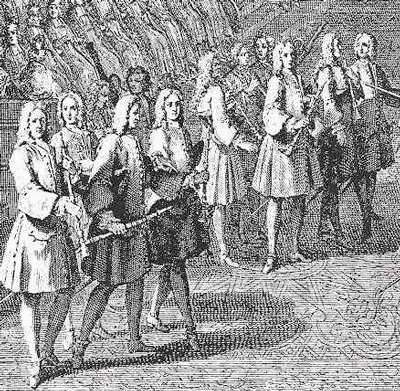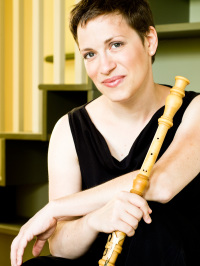by Mike Telin

On Saturday, October 25 at 8:00 pm at The Bop Stop and on Sunday, October 26 at 4:00 pm in the Herr Chapel at Plymouth Church, Les Délices artist director Debra Nagy will be joined by her baroque oboe colleagues Stephen Bard and Kathryn Montoya, baroque bassoonist Anna Marsh, percussionist Michelle Humphreys, and guitarist and theorboist, Simon Martyn-Ellis, in performances of music by Lully, Hotteterre, Philidor and others.
A 3:00 pm lecture by Kathryn Montoya will take place prior to Sunday’s concert. At 4:00 pm on Saturday at the Bop Stop, the ensemble will present “What’s an Oboe?” a 45-minute interactive presentation geared toward children 5-15 and their families.
“The Musketeers” is inspired by the bands that were organized in the French army by Louis XIV, comprising several large companies of soldiers armed with muskets. Each company of Musketeers included six drums and four double reed players — two oboes, a taille de hautbois (tenor oboe), and a bassoon. The musicians were officially employed as members of the King’s Grand Écurie, or the Great Stable, which included warhorses, riding school horses, and the staff that looked after them in addition to some of Louis XIV’s best musicians.
“It’s a rare thing to ever hear more than one or two oboes — let alone an ensemble made up entirely of double reeds in various shapes and sizes,” said Les Délices’s director Debra Nagy, who has handpicked this ensemble of the nation’s best players.
During a recent conference call, we asked the three oboists to talk about the program and their backgrounds. But with a concert that includes so much great wind-band music, we began by asking if they had a favorite piece.
Kathryn Montoya: Of all the oboe band pieces on the program the one I know best is Jean-Baptiste Lully’s Le Bourgeois gentilhomme. But for this program I’ll be playing taille de hautbois, which I love playing. It’s an extraordinary-sounding instrument. I love all of the dance movements, but the piece is also a concrete tie to the history when these were all functional instruments. I enjoy that aspect of it very much.
Stephen Bard: Le Bourgeois is also my favorite. It’s a piece I’ve performed numerous times in an orchestral setting, but I’ve never been able to experience it as an oboe band. So I am interested to see how we approach the music differently when we don’t have violins playing with us. The piece is filled with such great music as well.
Debra Nagy: I’m looking forward to the Pierre Philidor trio. There were many Philidors through the ages and for me Pierre’s music is extremely good. It’s very sophisticated and beautiful. This is kind of an unusual piece because essentially it is a piece that we have adapted to oboe band. It represents the classic, ceremonial side of what an oboe band did, along with high art and sophisticated music. It’s also a piece that I don’t think any of us have played before. So I’m looking forward to seeing how our oboe band will play with the line that exists between functional music and high art music.
Mike Telin: Debra, in your program notes you write: “When considering the history of wind playing in France, we encounter two family names over and over: Philidor and Hotteterre. Inspired by the great French songwriters of the seventeenth century, several generations from these families helped develop the wind instruments we play tonight.” Can someone talk a little bit about those important developments and how they changed/improved the instrument.
Kathryn Montoya: The primary changes that happened to the instrument were made in order to better accommodate singers. The changes made it more flexible, and able to imitate the inflections of the text better. The instrument’s bore become more narrow and there were many other changes, but it was all done for the purpose of making the instrument work in opera.
MT: In addition to baroque oboe, both Nagy and Montoya will double on recorder: is that an easy thing to do?
Kathryn Montoya: Certainly the more you do it the easier it gets. If you need to switch from oboe to English horn you’re dealing with two reeds of different sizes, but luckily, the recorder has no reed and there’s not really much of an embouchure problem with the instrument. However, there certainly is a change in how the air pressure feels and how you use your wind, and that’s the big difference between oboe and recorder. The fact that the recorder is essentially a whistle makes it an easier switch, at least for me. They’re separate enough that they live in different compartments in my head. But for example, switching from oboe to bass recorder, as I have had to do, does take a while to get used to.
MT: What led each of you to decide to pursue baroque oboe as your instrument of choice?
Stephen Bard: I was always interested in both contemporary music and early music as a teenager. I had been accepted to join the modern oboe studio at Oberlin when my mother received a pamphlet in the mail that listed all of the school’s summer festival opportunities including scholarships for high school students to attend the Baroque Performance Institute. So I went and was given an instrument, a reed, and a fingering chart. That was it. But when I heard the faculty play, I thought gosh, if I can make my modern oboe sound like that I would be very happy, and I was hooked at that point. Then at Oberlin I was able to continue my studies on baroque oboe and ultimately decided to make it my major.
Kathryn Montoya: I played piano, flute and euphonium before I eventually settled on modern oboe. I too went to Oberlin and while I was there I heard performances of the historical performance department and really enjoyed those concerts. I started taking recorder lessons and later moved on to baroque oboe. I think the music, no matter if it is in an orchestral setting or smaller ensembles, is always chamber music and more conversational. There’s just something more intimate about it and I like the freedom that that offers. So that’s what draws me to it.
Debra Nagy: My story is a fusion of Stephen’s and Kathryn’s. I loved and played a lot of baroque music as a high school student on modern oboe. But when I eventually arrived at Oberlin, I too found myself with an opportunity to get a scholarship to attend the Baroque Performance Institute. Like Stephen, when I heard the faculty play I thought, wow, that’s what I would like to do, and it was a very natural fit for me. There was the added appeal that like Kathryn, chamber music was always where it was at for me. And the fact that I could conceivably make a life in music, to some degree or another, exclusively playing chamber music was extremely appealing.
To listen to the extraordinary sound produced by an oboe band check out this recording by the London Oboe Band.
Published on ClevelandClassical.com October 21, 2014.
Click here for a printable copy of this article




